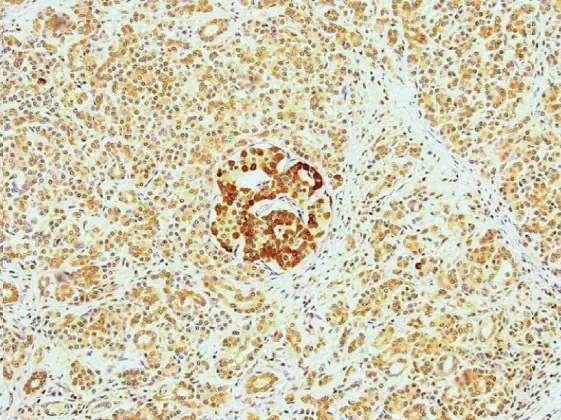

School Researchers Publish on New Therapeutic Targets for Pancreatic Cancer
Researchers based in the School of Biotechnology/National Institute for Cellular Biotechnology have recently highlighted the influence and therapeutic potential of one particular microRNA in the context of pancreatic cancer.
This work is the subject of a recent published article in the Journal of Oncology by the Naomi Walsh Cancer Research Group, in collaboration with partners in St. Vincent’s University Hospital. The group has shown using sophisticated genetic profiling approaches, how the let-7c microRNA is not only downregulated in the cells which comprise pancreatic tumours, but targeting its activity can effectively neutralise the cancer-specific behaviour that pancreatic cells adopt as part of the disease’s pathogenesis.
‘Pancreatic cancer is one of the major causes of cancer-related mortality worldwide’, explains Shannon Nelson; first author on the publication, ‘and while diagnosis and treatment of other forms of cancer are steadily improving, pancreatic cancer remains problematic in that it is notoriously asymptomatic and is incredibly difficult to detect at an early, and possibly treatable, stage’.
‘If caught early, surgical interventions can cure the condition, however, a problem resides in that owing to the aforementioned lack of symptoms associated with this disease, 80% are diagnosed after the cancer has metastasized, making them ineligible for this treatment’.
‘Taken together, treatment of pancreatic cancer represents a current major clinical challenge, and by studying the microRNA profile of pancreatic cells; which we have done in this study, we believe we have identified new biomarkers and potential therapeutic targets for the treatment of such’.
Targeted therapies in cancer treatment often target specific genes or proteins that have been shown to be involved in the growth, survival, and overall development of cancer cells. While there has been several successes with this approach in the context of treating certain forms of cancer, the development of a targeted therapy is complex in that owing to the vastness of the genome and resultant proteome of cancer cells, finding a target which is inherent of that cancer, is responsive to treatment, and elicits no serious side effects, can be huge undertaking.
‘MicroRNAs are small, non-coding genetic strands that ultimately influence the population of proteins, or the proteome, expressed in a single cell,’ describes Dr. Naomi Walsh; senior author of the publication.
‘With microRNAs shown to regulate several key proteins involved in cancer-related cell activity and the subsequent development of tumours, we employed an approach whereby we screened and profiled the levels of hundreds of individual microRNAs in invasive and non-invasive models of pancreatic cancer in order to identify which ones are differently expressed, and therefore most likely, to influence the aggressive, cancer-related behaviour inherent to those cells’.
‘In doing so, we found a particular microRNA; let-7c, was significantly reduced, and using computational approaches to model what it specifically targets we found this microRNA regulates the activity of the SOX13 gene and therefore protein within the cell’.
‘With the let-7c microRNA reduced, the level of protein SOX13 in the cells increases, promoting the invasive behaviour which is associated with pancreatic cancer. In fact, samples from our collaborators in St. Vincent’s University Hospital corroborated this, in demonstrating SOX13 levels are increased in pancreatic tumours, suggesting this protein, or indeed the let-7c microRNA, could be a viable target in diagnosing and/or designing a targeted therapy for the disease’.
‘This study adds to the wealth of knowledge on the influence of microRNAs in the context of health and disease, and demonstrates the therapeutic potential of targeting miRNAs, such as the let-7 family, in the context of difficult to treat diseases such as pancreatic cancer’.
‘With further investigation into mechanisms that contribute to the aggressive nature of this particular cancer, we firmly believe we can improve the approaches for diagnosis and prognosis of the disease, ultimately reducing the significant impact it has on the global population today’
For more information, the article can be found here.
